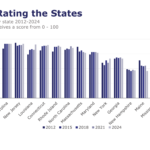The property/casualty insurance and group benefits industry is changing faster than ever—or at least faster than any time in any reader’s history. Many factors are responsible for the change. Part 1 of this two-part series focuses on the more traditional aspects and effects on agencies—the old-fashioned pricing cycle.
In the “old” days, only about 10 years ago, the P/C industry would go through hard and soft market cycles. Typically, companies would underprice or excessively relax their underwriting standards in an effort to grow more quickly. Insurance company executives were always confident, assuring that this time, they were pricing correctly. They were wrong.
Their mistake or excessive confidence would then lead to a hard market where prices increased 10-50 percent upon renewal and coverages became difficult to obtain. In the most infamous hard market in my memory, the mid-80s, some liability coverages were simply not realistically obtainable.
Companies had to turn the market hard to make up for their underpricing sins, incompetency or both. Warren Buffett summed up the situation extremely well when he wrote in Berkshire Hathaway’s annual report, “In 1999, a number of insurers announced reserve adjustments that made a mockery of the ‘earnings’ that investors had relied on earlier when making their buy-and-sell decisions.”
Some companies did not play this game and became known as “hard market” companies. These were companies agents could really count on when a difficult hard market arrived. Because they would not play the pricing game in a soft market, they suffered in the soft market. Agencies then had to have soft market and hard market companies.
Soft and Hard Agencies
Agencies also could often be divided into hard and soft market agencies.
Soft market agencies sold price. They grew more quickly in soft markets because they could always find a cheaper price. Sometimes prices dropped so fast they could cause clients to move midterm. In hard markets, they suffered. They had absolutely nothing legitimate to offer their clients.
Hard market agencies grew in tough times because they held onto their existing accounts, but at much higher rates. They also gained accounts because they had the companies that would write in a hard market. (Hard markets are historically correlated with a higher number of insolvencies and downgrades.) They generally also made much more contingency money because hard market agencies tended to be better upfront underwriters.
The cycle more or less evened out. Companies and agencies were fairly clear about their place in the market cycle. Some companies and agencies did not make it through the extremes of either part of the cycle, and that was just an accepted reality.
The P/C market has now been in a soft market for 13 years. That is longer than any soft market I can find going back to 1900. Net premiums written (NPW) growth has not exceeded 4.4 percent once in that time. Looking forward, growth is not likely to accelerate. This long and deep soft market has far-reaching impacts.
Hard Times
First, hard market agencies have had to transform or sell, because they were based on the cycle turning roughly at least every seven years. Beyond that, they would fall too far behind soft market agencies. A hard market would last three or four years, generating enough growth to see them through the next seven years. In a long soft market, they fell too far behind, which may be a factor in them selling.
The second nail in hard market agencies’ coffins is how these agencies were, generally, better underwriters. Between waiting for the large bump a hard market gave to their revenues and the often much higher contingencies earned, hard market agencies did not work hard truly selling. They were more reactive, waiting for customers to find them or waiting for the right time (a hard market) to make a sale.
In my experience, hard market agencies often had no sales culture whatsoever, whereas soft market agencies did, sometimes to the extreme where the producers were incompetent or even unethical. Few agencies were truly in the middle, which was a point of frustration for carriers.
A soft market is created by adequate to excess surplus and profitability; a hard market requires lack of profit and, most importantly, a dangerous decline in surplus. Both factors will almost definitely create a really hard market.
In today’s markets, carriers in total have made a large profit every year since 2002. Their average profit the last 20 years is $37 billion on both a pretax and net income basis. Why do carriers need to raise rates and create a hard market when they are making $37 billion each year? Because surplus is more important than profits relative to the market turning hard, and industry surplus hit an all-time high in 2016.
Using A.M. Best data, surplus is now approximately 2.7 times what it was in 1996. Surplus has increased by approximately 172 percent during this time, while premiums have only increased approximately 97 percent. With so much surplus, and so much profit, the probability of the market remaining soft, even getting more soft, is far higher than the probability of it turning hard.
Organic Growth
Hard market agencies may simply not have a place in this industry. Making their situation worse, carriers still need growth, especially if they are stock companies. Hard market agencies grew with rates historically or through client duress (clients came to them when their soft market agency could not find a carrier for them in a hard market). They did not typically proactively go out and find new clients.
In a perpetual soft market, proactively going out and finding new clients is an absolute must. Many hard market agencies simply do not have the tools or culture to make this happen. They have to reinvent themselves. If an agency cannot generate material organic growth, it probably will not survive.
Another environmental factor pushing the extinction of hard market agencies (and companies) is the invention and use of predictive modeling and the further development of quality behavioral underwriting/pricing models. These models “promise” more exact pricing based on a dataset. Much of that dataset used to be provided by the agency. This was upfront underwriting—the upfront data the agency gained by being on premise and knowing the consumer. In theory, predictive models, and their behavioral economic successors, obviate the data and vetting service historically provided by an agency.
This means that companies, whether they admit it or not, do not truly need agencies doing upfront underwriting. Agents are frustrated by the emphasis companies are placing in contingencies on growth and what they see as a de-emphasis on upfront underwriting, better known as loss ratios.
Hard market agencies quite often ran sloppy sales shops but earned high contingencies because their upfront underwriting was so good. The companies do not necessarily value that model today.
Devaluing upfront underwriting further is that outside technology is completely changing the nature and frequency of claims. Between the promise of automotive technology to decrease auto claims enough to reduce auto premiums by 20 percent and the even bigger potential for water leak sensors to almost eliminate non-cat water damage claims, plus the exciting new employee safety technology, companies may find themselves making money no matter how bad their management is.
Knowing insurance companies, some will still be so incompetent they will die, but profitability should not be a problem. The issue is that when claims decrease, premiums eventually decrease, and therefore companies need growth.
The industry has already been through the longest soft market in history, and barring a catastrophe or black swan event, the market is likely to remain extremely soft for the foreseeable future. A soft market always puts a premium on growth. The agencies and companies that can generate organic growth have the best opportunity at outsized success.





















 IBHS: Virginia Edges Florida Out of First Place in Building Code Adoption
IBHS: Virginia Edges Florida Out of First Place in Building Code Adoption  Fitch: U.S. Cyber Insurers Saw Strong Profits, Slowdown in Premium Growth in 2023
Fitch: U.S. Cyber Insurers Saw Strong Profits, Slowdown in Premium Growth in 2023  Time-Tested Loss Reserving Methods Challenged: AM Best
Time-Tested Loss Reserving Methods Challenged: AM Best  P/C Insurance Execs, Underwriters Out of Sync on Advanced Tech
P/C Insurance Execs, Underwriters Out of Sync on Advanced Tech 
